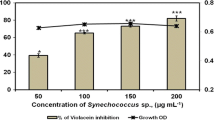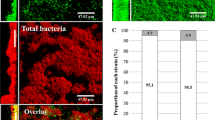Abstract
V. harveyi is a well-known pathogen-inducing vibriosis, especially for shrimp, fish, and invertebrates. Its virulence is related to biofilm formation and this negatively impacts the aquaculture industry. Therapeutic strategies such as the utilization of probiotic bacteria may slow down Vibrio infections. In this study, we investigated the potential antibiofilm activity of the probiotic Bacillus subtilis C3 for aquaculture. First, B. subtilis C3 biofilm was characterized by confocal laser scanning microscopy (CLSM) before testing its bioactivities. We demonstrated antibiofilm activity of B. subtilis C3 culture supernatant, which is mainly composed—among other molecules—of lipopeptidic surfactants belonging to the surfactin family as identified by ultra-high-performance liquid chromatography (UHPLC)-MS/MS. Their antibiofilm activity was confirmed on V. harveyi ORM4 (pFD086) biofilm by CLSM. These findings suggest that the marine probiotic B. subtilis C3 might inhibit or reduce Vibrio colonization and thus decrease the associated animal mortalities.






Similar content being viewed by others
Data Availability
Raw data are available on request from the corresponding author.
References
Zhang X-H, He X, Austin B (2020) Vibrio harveyi: a serious pathogen of fish and invertebrates in mariculture. Mar Life Sci Technol 2(3):231–245. https://doi.org/10.1007/s42995-020-00037-z
de Souza Valente C, Wan AH (2021) Vibrio and major commercially important vibriosis diseases in decapod crustaceans. J Invertebr Pathol 181:107527. https://doi.org/10.1016/j.jip.2020.107527
Le Groumellec M, Haffner P, Martin B, Martin C (1993) Comparative study of bacterial infections responsible for mass mortality in penaeid shrimp hatcheries of the Pacific zone. Second Symposium on Diseases in Asian Aquaculture. Available: https://archimer.ifremer.fr/doc/00000/6100/
Rather MA, Gupta K, Mandal M (2021) Microbial biofilm: formation, architecture, antibiotic resistance, and control strategies. Braz J Microbiol 52(4):1701–1718. https://doi.org/10.1007/s42770-021-00624-x
Nayak SK (2021) Multifaceted applications of probiotic Bacillus species in aquaculture with special reference to Bacillus subtilis. Rev Aquac 13(2):862–906. https://doi.org/10.1111/raq.12503
Binda S et al (2020) Criteria to qualify microorganisms as “Probiotic” in foods and dietary supplements Front. Microbiol 11 [Online]. https://doi.org/10.3389/fmicb.2020.01662
Yaylacı EU (2021) Isolation and characterization of Bacillus spp. from aquaculture cage water and its inhibitory effect against selected Vibrio spp. Arch Microbiol 204(1):26. https://doi.org/10.1007/s00203-021-02657-0
Khochamit N, Siripornadulsil S, Sukon P, Siripornadulsil W (2015) Antibacterial activity and genotypic-phenotypic characteristics of bacteriocin-producing Bacillus subtilis KKU213: potential as a probiotic strain. Microbiol Res 170:36–50. https://doi.org/10.1016/j.micres.2014.09.004
Iqbal S et al (2023) Classification and multifaceted potential of secondary metabolites produced by Bacillus subtilis group: a comprehensive review. Molecules vol. 28, no. 3, Art. no. 3. https://doi.org/10.3390/molecules28030927
Sharma G, Dang S, Gupta S, Gabrani R (2018) Antibacterial activity, cytotoxicity, and the mechanism of action of bacteriocin from Bacillus subtilis GAS101. Med Princ Pract 27(2):186–192. https://doi.org/10.1159/000487306
Ferreira WT et al (2021) Micellar antibiotics of Bacillus. Pharmaceutics 13(8):1296. https://doi.org/10.3390/pharmaceutics13081296
Moro GV et al (2018) Identification and ultra-high-performance liquid chromatography coupled with high-resolution mass spectrometry characterization of biosurfactants, including a new surfactin, isolated from oil-contaminated environments. Microb Biotechnol 11(4):759–769. https://doi.org/10.1111/1751-7915.13276
Théatre A et al (2021) The surfactin-like lipopeptides from Bacillus spp.: natural biodiversity and synthetic biology for a broader application range. Front Bioeng Biotechnol vol. 9:p. 623701. https://doi.org/10.3389/fbioe.2021.623701
Ledger EVK, Sabnis A, Edwards AM (2022) Polymyxin and lipopeptide antibiotics: membrane-targeting drugs of last resort. Microbiol Read Engl 168(2):001136. https://doi.org/10.1099/mic.0.001136
Nicolas J-L, Olivier B, Mazurie J, Thebault A (2002) Vibrio carchariae, a pathogen of the abalone Haliotis tuberculata. Dis Aquat Organ 50:35–43. https://doi.org/10.3354/dao050035
Morot A et al (2021) Virulence of Vibrio harveyi ORM4 towards the European abalone Haliotis tuberculata involves both quorum sensing and a type III secretion system. Environ Microbiol 23(9):5273–5288. https://doi.org/10.1111/1462-2920.15592
Chen MC, Wang JP, Zhu YJ, Lui B, Yang WJ, Ruan CQ (2019) Antibacterial activity against Ralstonia solanacearum of the lipopeptides secreted from the Bacillus amyloliquefaciens strain FJAT-2349. J Appl Microbiol 126(5):1519–1529. https://doi.org/10.1111/jam.14213
Sanchez-Vizuete P et al (2022) The coordinated population redistribution between Bacillus subtilis submerged biofilm and liquid-air pellicle. Biofilm 4:100065. https://doi.org/10.1016/j.bioflm.2021.100065
El-Khoury N et al (2021) Massive integration of planktonic cells within a develo** biofilm. Microorganisms vol. 9 no. 2. https://doi.org/10.3390/microorganisms9020298
Ardré M, Henry H, Douarche C, Plapp M (2015) An individual-based model for biofilm formation at liquid surfaces. Phys Biol 12(6):066015. https://doi.org/10.1088/1478-3975/12/6/066015
Alonso VPP, Harada AMM, Kabuki DY (2020) Competitive and/or cooperative interactions of Listeria monocytogenes with Bacillus cereus in dual-species biofilm formation. Front Microbiol 11:177. https://doi.org/10.3389/fmicb.2020.00177
Monmeyran A et al (2021) Four species of bacteria deterministically assemble to form a stable biofilm in a millifluidic channel. Npj Biofilms Microbiomes vol. 7 no. 1. https://doi.org/10.1038/s41522-021-00233-4
Sadiq FA, De Reu K, Burmølle M, Maes S, Heyndrickx M (2023) Synergistic interactions in multispecies biofilm combinations of bacterial isolates recovered from diverse food processing industries. Front Microbiol 14:1159434. https://doi.org/10.3389/fmicb.2023.1159434
Jautzus T, van Gestel J, Kovács ÁT (2022) Complex extracellular biology drives surface competition during colony expansion in Bacillus subtilis. ISME J 16(10):2320–2328. https://doi.org/10.1038/s41396-022-01279-8
Parijs I, Steenackers HP (2018) Competitive inter-species interactions underlie the increased antimicrobial tolerance in multispecies brewery biofilms. ISME J 12(8). https://doi.org/10.1038/s41396-018-0146-5
Berne C, Ducret A, Hardy GG, Brun YV (2015) Adhesins involved in attachment to abiotic surfaces by Gram negative bacteria Microbiol Spectr 3(4):10.1128. https://doi.org/10.1128/microbiolspec.MB-0018-2015
Yannarell SM, Grandchamp GM, Chen S-Y, Daniels KE, Shank EA (2019) A dual-species biofilm with emergent mechanical and protective properties. J Bacteriol 201(18):e00670-e718. https://doi.org/10.1128/JB.00670-18
Zhao H et al (2017) Biological activity of lipopeptides from Bacillus. Appl Microbiol Biotechnol 101(15):5951–5960. https://doi.org/10.1007/s00253-017-8396-0
El Aichar F, Muras A, Parga A, Otero A, Nateche F (2022) Quorum quenching and anti-biofilm activities of halotolerant Bacillus strains isolated in different environments in Algeria. J Appl Microbiol 132(3):1825–1839. https://doi.org/10.1111/jam.15355
Tang J-S et al (2010) Characterization and online detection of surfactin isomers based on HPLC-MSn analyses and their inhibitory effects on the overproduction of nitric oxide and the release of TNF-α and IL-6 in LPS-induced macrophages. Mar Drugs 8(10):2605–2618. https://doi.org/10.3390/md8102605
Peypoux F, Bonmatin JM, Wallach J (1999) Recent trends in the biochemistry of surfactin. Appl Microbiol Biotechnol 51(5):553–563. https://doi.org/10.1007/s002530051432
Pathak KV, Bose A, Keharia H (2014) Characterization of novel lipopeptides produced by Bacillus tequilensis P15 using liquid chromatography coupled electron spray ionization tandem mass spectrometry (LC–ESI–MS/MS)’. Int J Pept Res Ther 20(2):133–143. https://doi.org/10.1007/s10989-013-9375-7
Wei Y-H, Wang L-F, Changy J-S, Kung S-S (2003) Identification of induced acidification in iron-enriched cultures of Bacillus subtilis during biosurfactant fermentation. J Biosci Bioeng 96(2):174–178. https://doi.org/10.1016/S1389-1723(03)90121-6
Lin S-C, Jiang H-J (1997) Recovery and purification of the lipopeptide biosurfactant of Bacillus subtilis by ultrafiltration. Biotechnol Tech 11(6):413–416. https://doi.org/10.1023/A:1018468723132
Vater J, Kablitz B, Wilde C, Franke P, Mehta N, Cameotra SS (2002) Matrix-assisted laser desorption ionization-time of flight mass spectrometry of lipopeptide biosurfactants in whole cells and culture filtrates of Bacillus subtilis C-1 isolated from petroleum sludge. Appl Environ Microbiol 68(12):6210–6219. https://doi.org/10.1128/AEM.68.12.6210-6219.2002
Rahman FB, Sarkar B, Moni R, Rahman MS (2021) Molecular genetics of surfactin and its effects on different sub-populations of Bacillus subtilis. Biotechnol Rep 32:e00686. https://doi.org/10.1016/j.btre.2021.e00686
Abdelli F et al (2019) Antibacterial, anti-adherent and cytotoxic activities of surfactin(s) from a lipolytic strain Bacillus safensis F4. Biodegradation 30(4):287–300. https://doi.org/10.1007/s10532-018-09865-4
Pandur Ž, Penič S, Iglič A, Kralj-Iglič V, Stopar D, Drab M (2023) Surfactin molecules with a cone-like structure promote the formation of membrane domains with negative spontaneous curvature and induce membrane invaginations. J Colloid Interface Sci 650:1193–1200. https://doi.org/10.1016/j.jcis.2023.07.057
Xu HM, Rong YJ, Zhao MX, Song B, Chi ZM (2014) Antibacterial activity of the lipopetides produced by Bacillus amyloliquefaciens M1 against multidrug-resistant Vibrio spp. isolated from diseased marine animals. Appl Microbiol Biotechnol 98(1):127–136. https://doi.org/10.1007/s00253-013-5291-1
Acknowledgements
Strains: We are grateful to François Delavat and Christine Paillard for the kind gift of V. harveyi ORM4 GFP (pFD086).
Funding
This research received funding from Plan de relance France 2030 and Biotech and Health AAP of Brittany region.
Author information
Authors and Affiliations
Contributions
Conceptualization, A.B., F.G., C.L.K., and C.P.; methodology, A.B., S.R., C.L.K., and L.T.; software, C.P.; validation, A.B., S.R., and F.G.; formal analysis, C.P.; investigation, C.P., L.T., and F.C.; data curation, C.P.; writing—original draft preparation, C.P. and A.B.; writing—review and editing, A.B., C.P., A.D., and S.R.; supervision, A.B. and F.G.; funding acquisition, A.B., C.L.K., and F.G. All authors have read and agreed to the published version of the manuscript.
Corresponding author
Ethics declarations
Institutional Review Board
Not applicable.
Informed Consent
Not applicable.
Competing Interests
The authors declare no competing interests.
Additional information
Publisher's Note
Springer Nature remains neutral with regard to jurisdictional claims in published maps and institutional affiliations.
Rights and permissions
Springer Nature or its licensor (e.g. a society or other partner) holds exclusive rights to this article under a publishing agreement with the author(s) or other rightsholder(s); author self-archiving of the accepted manuscript version of this article is solely governed by the terms of such publishing agreement and applicable law.
About this article
Cite this article
Petit, C., Caudal, F., Taupin, L. et al. Antibiofilm Activity of the Marine Probiotic Bacillus subtilis C3 Against the Aquaculture-Relevant Pathogen Vibrio harveyi. Probiotics & Antimicro. Prot. (2024). https://doi.org/10.1007/s12602-024-10229-z
Accepted:
Published:
DOI: https://doi.org/10.1007/s12602-024-10229-z




